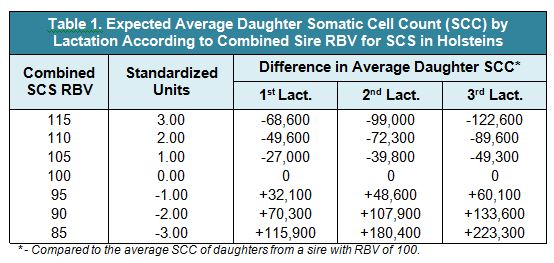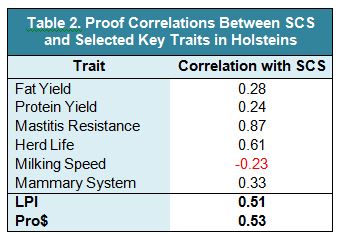Starting in December 2018, proofs for Somatic Cell Score (SCS) will be expressed as Relative Breeding Values (RBV) in order to improve interpretation and be consistent with all other functional trait expression. On the RBV scale, bull proofs for SCS will be expressed using a value of 100 as breed average and a standard deviation of 5. The most extreme bulls vary from the most undesirable at around 85 to the most desirable at 115.
In general, daughters of bulls with a better than average RBV for SCS will produce milk with a lower Somatic Cell Count (SCC) than daughters of bulls with an RBV for SCS that is average or poorer. In order to help with interpretation of this important trait, Canadian Dairy Network (CDN) has conducted an analysis relating sire RBV for SCS to the average daughter performance for SCC.
Sire RBV and Expected Daughter Performance
Bull proofs for SCS are calculated using the Canadian Test Day Model and each bull receives a separate proof for first, second and third lactation. These three values are combined into a single published proof. The CDN analysis compared each bull’s combined SCS RBV to the average somatic cell count (SCC) of their daughters on test day. Since the average SCC is expected to be different across lactations, the relationship between RBV and average daughter performance was performed separately for first, second and third lactation.
Figure 1 shows the average daughter SCC in each lactation relative to their sire’s overall SCS proof, expressed as an RBV, which is a combination of his genetic potential for each of the three lactations. Although not all bulls have exactly the same relationship between proof and daughter average performance, the three solid lines in Figure 1 show the general relationship within each lactation. This graph clearly demonstrates the trend of higher somatic cell counts associated with each successive lactation.
The actual results in Figure 1 can also be used to establish a table to help translate sire proofs for SCS into the expected average SCC for future daughters. Table 1 provides the difference in average SCC for daughters in first, second or third lactation according to the published SCS RBV of their sire. In addition to being influenced by genetics, actual SCC levels are significantly impacted by herd management. For this reason, expression of expected daughter performance differences in Table 1 are all relative to how daughters of an average sire with an RBV of 100 would perform. In this manner, Table 1 applies to expected performance in all herds regardless of herd management levels. Considering a herd with an average SCC of 140,000 in first lactation cows as an example, future daughters of a bull with an SCS RBV of 105 should have an average first lactation SCC of approximately 113,000 (140,000-27,000).
In general, the higher the sire RBV for SCS, the lower the average daughter SCC across all lactations. Research has shown that SCC generally increases with each lactation. This occurs more drastically in daughters of sires with poor RBVs for SCS. In other words, the more undesirable the sire RBV for SCS, the greater the increase in average daughter SCC from one lactation to the next. For example, daughters of sires with an SCS RBV of 85 have an average increase of nearly 107,400 SCC (223,300-115,900) between first and third lactation, while daughters of sires with an SCS RBV of 115 increase only half that amount with an average of 54,000 SCC (122,600-68,600) between first and third lactation.
Correlations Between SCS and Other Key Traits
Table 2 shows proof correlations between SCS and selected key traits derived using data from >4,000 domestically proven Holstein bulls.
In general, most traits are positively correlated with SCS meaning selection will be favorable toward reducing SCC. In particular, SCS is positively correlated with production yields, Herd Life, Mammary System and both national indexes. Milking Speed is one exception, where the negative correlation indicates that the higher the RBV for Milking Speed, the less desirable (lower) the RBV for SCS. This means that strong selection to improve somatic cell counts would indirectly lead to an increased frequency of slower milking cows in the herd. Not surprisingly, Mastitis Resistance is highly correlated with SCS at 87%. Since Mastitis Resistance is an index that combines both Somatic Cell Score and Clinical Mastitis, it should be the primary trait considered when making selection and mating decisions to reduce the incidence of mastitis.
Summary
SCS on an RBV scale will lead to consistency of expression and interpretation of all functional traits, as well as allow producers to more easily monitor proof changes. With herd average SCC levels as a starting point, RBV for SCS can be related to the expected average daughter performance for SCC. In general, the higher the sire RBV for SCS, the better (lower) the daughter performance for SCC. Also, poor RBV for SCS are associated with more dramatic SCC increases with each consecutive lactation in daughters. As a trait, SCS has favorable correlations with many important traits including moderate correlations with both national indexes, which means that with selection, simultaneous improvements are made for both. For breeds with Mastitis Resistance available, using this trait is the optimal way to genetically improve your herd for resistance to both clinical and sub-clinical mastitis.
Authors:
Lynsay Beavers, Industry Liaison Coordinator, CDN
Brian Van Doormaal, General Manager, CDN
Download a PDF copy of this article







.JPG)






